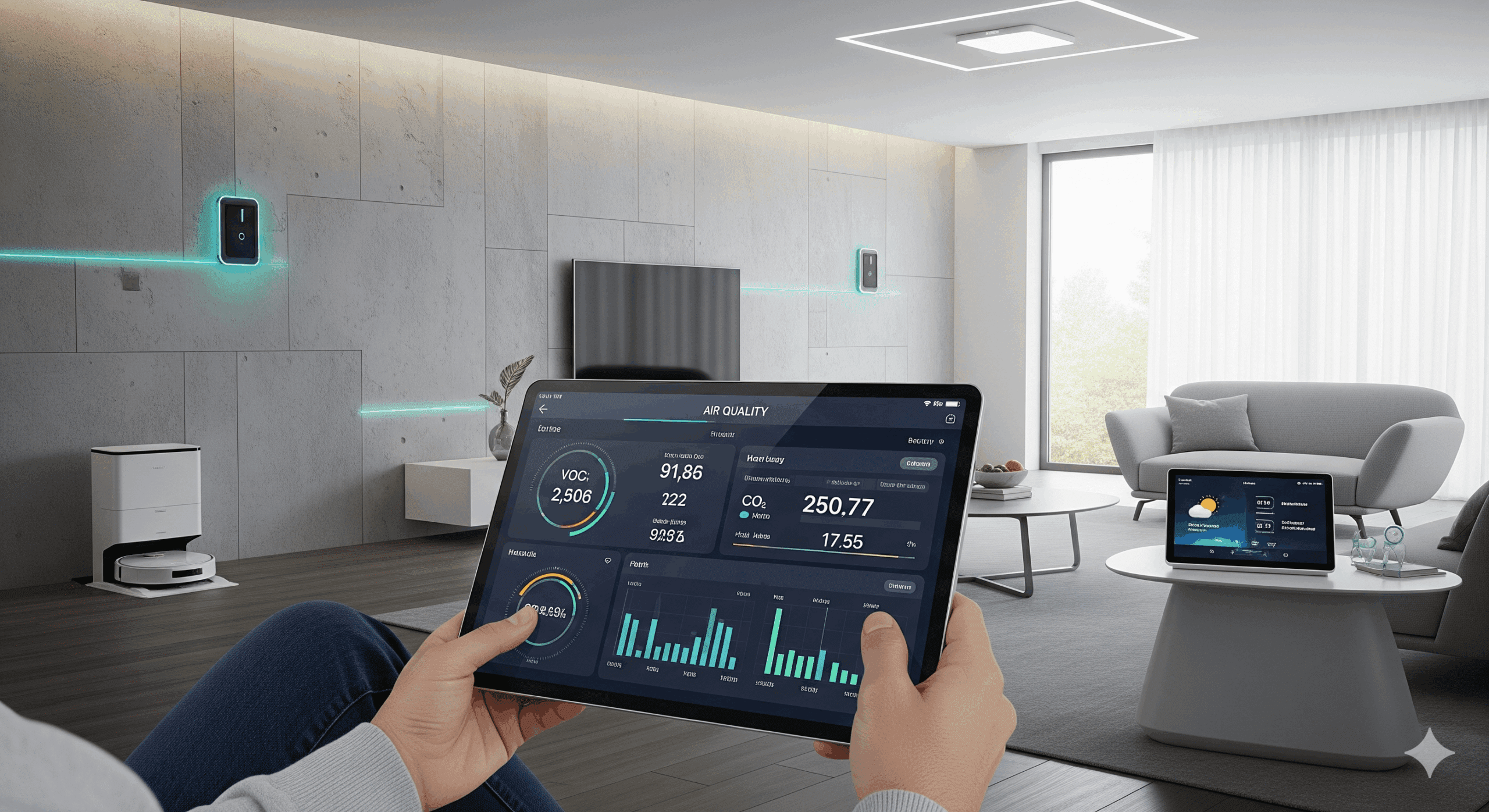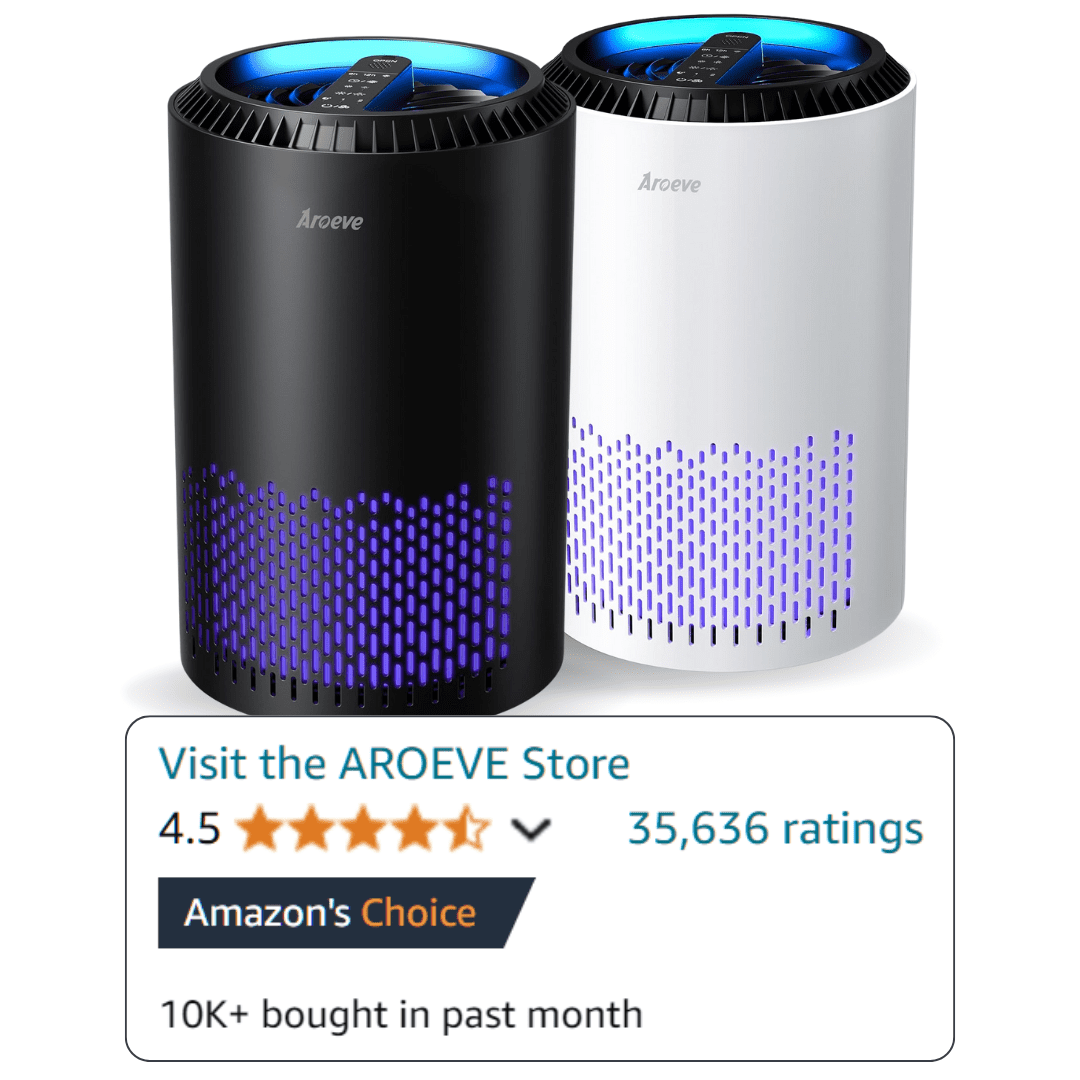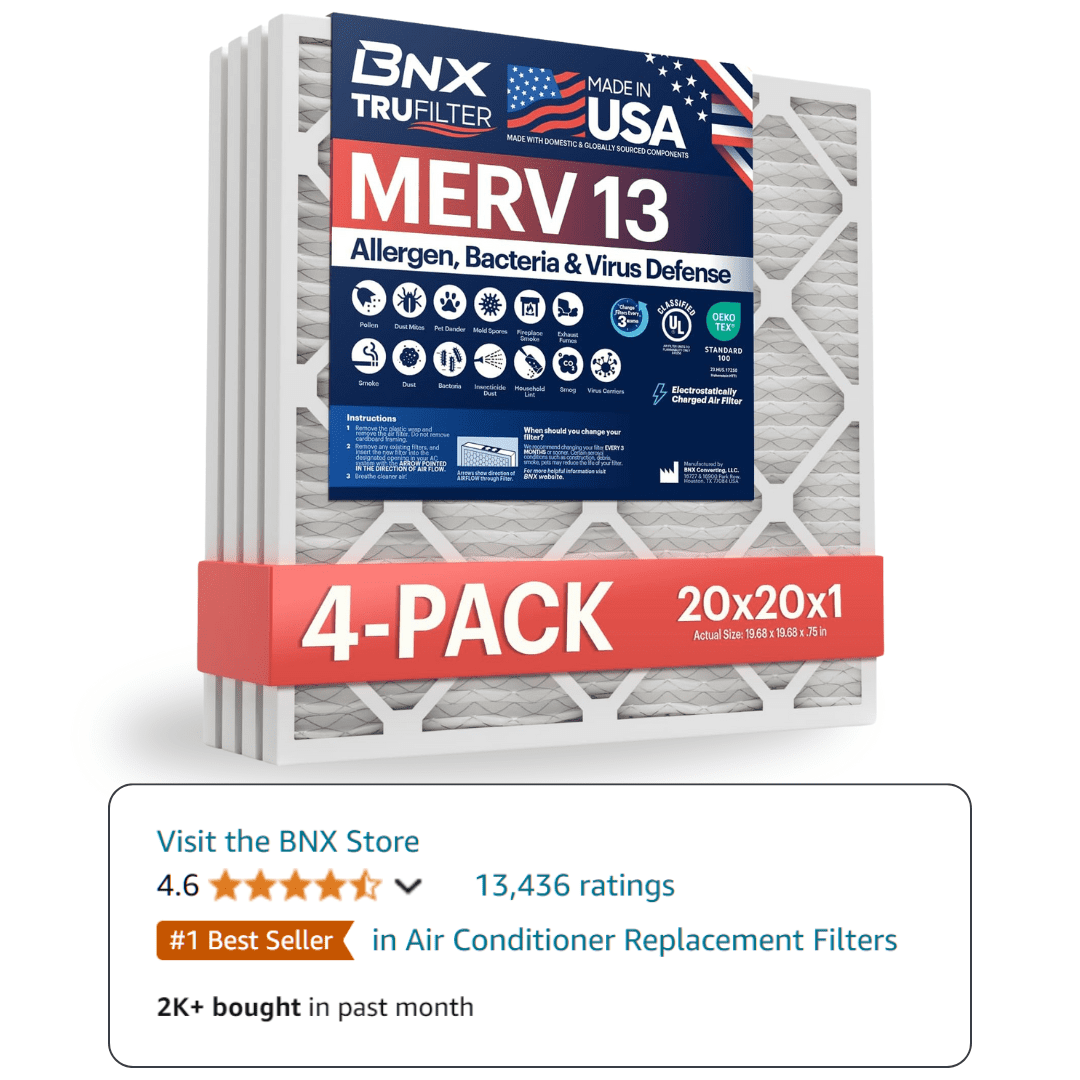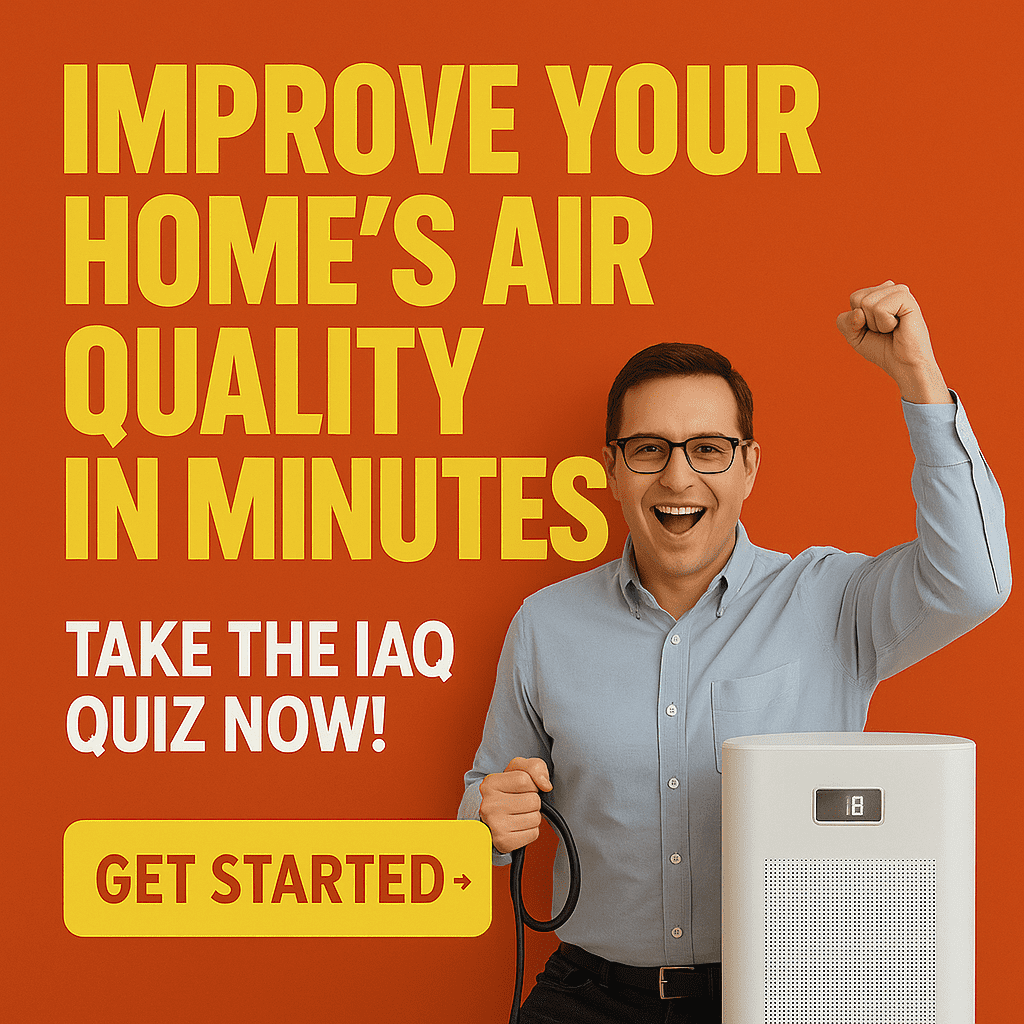Why Smart IAQ Monitoring Matters for Modern Homes
Health benefits of continuous monitoring
Continuous air quality monitoring provides real-time protection against invisible threats that intermittent testing misses. PM2.5 particles can spike during cooking, cleaning, or when outdoor pollution infiltrates your home. Smart systems detect these changes within minutes and trigger immediate responses.
The EPA’s research on indoor air exposure shows that people spend 90% of their time indoors, where pollutant concentrations can be 2-5 times higher than outdoors. Smart monitoring systems address this by tracking multiple parameters simultaneously – something impossible with manual testing.
VOC levels fluctuate throughout the day based on activities like cleaning, cooking, or using personal care products. Smart sensors provide VOC monitoring capabilities that alert you to dangerous spikes before symptoms appear. This early warning system prevents headaches, respiratory irritation, and long-term health impacts.
Carbon dioxide buildup indicates inadequate ventilation and can impair cognitive function. Studies show CO2 levels above 1,000 ppm reduce decision-making ability by 15%. Smart systems maintain optimal levels automatically through ventilation control.
Energy efficiency through automated responses
Smart IAQ systems optimize energy consumption by running equipment only when needed. Traditional HVAC systems operate on schedules regardless of actual air quality conditions. Smart integration reduces energy waste by 20-30% while maintaining better air quality.
Humidity control automation prevents energy-wasting overcorrection. When humidity rises above 60%, smart systems activate dehumidification gradually rather than running continuously. This humidity control automation maintains the ideal 40-60% range efficiently.
Predictive algorithms learn your home’s air quality patterns and pre-condition spaces before problems occur. If outdoor air quality deteriorates, the system automatically switches to recirculation mode and increases filtration without manual intervention.
Essential Components of Smart IAQ Systems
Multi-parameter sensors (PM2.5, VOCs, CO2, humidity)
Professional-grade smart IAQ systems monitor at least four critical parameters simultaneously. PM2.5 sensors detect particles that penetrate deep into lungs and cause cardiovascular problems. Quality sensors use laser scattering technology with accuracy within 10% of reference-grade equipment.
VOC sensors detect hundreds of chemical compounds from cleaning products, furniture, and building materials. Advanced systems differentiate between harmful VOCs like formaldehyde and benign compounds, reducing false alarms while maintaining protection.
CO2 sensors indicate ventilation effectiveness and occupancy levels. Dual-beam NDIR sensors provide laboratory-grade accuracy and don’t drift over time like single-beam alternatives. This technology ensures reliable readings for automated ventilation control.
Temperature and humidity sensors work together to calculate dew point and prevent condensation problems. Integrated systems use this data to coordinate heating, cooling, and humidity control for optimal comfort and air quality.
Smart HVAC integration capabilities
Direct HVAC integration eliminates the delay between detection and response that plagues standalone monitors. Smart systems connect to your thermostat, air handler, and ventilation equipment through standard protocols like Modbus or proprietary interfaces.
Zone-based control allows different responses in different areas. If cooking generates particles in the kitchen, the system increases exhaust ventilation there while maintaining normal operation in bedrooms. This targeted approach improves efficiency and comfort.
Filter monitoring tracks pressure drop across air filters and alerts you when replacement is needed. Smart systems can even order replacement filters automatically based on your specific MERV rating and usage patterns.
Mobile app and notification features
Professional IAQ apps provide actionable insights beyond simple readings. They translate sensor data into health recommendations, energy optimization suggestions, and maintenance reminders. Quality apps include historical trending, outdoor air quality integration, and family member health tracking.
Geofencing technology adjusts your home’s air quality based on your location. When you’re away, the system reduces ventilation to save energy. As you approach home, it pre-conditions the air to optimal levels.
Emergency notifications alert you to dangerous conditions like gas leaks, smoke, or extreme pollution events. These alerts include specific actions to take, not just warnings about problems.
Top Smart IAQ Monitoring Systems Compared
Whole-home integrated solutions
Whole-home systems provide comprehensive coverage through centralized monitoring and distributed sensors. The Honeywell IAQ Monitor integrates with most HVAC systems and provides professional-grade accuracy for PM2.5, VOCs, CO2, and humidity. Installation requires HVAC technician expertise but provides seamless automation.
The Ecobee Smart Thermostat with IAQ monitoring combines climate control with air quality management. Its room sensors detect occupancy and air quality, adjusting ventilation and filtration accordingly. The system learns your preferences and optimizes automatically.
Carrier’s Infinity Air Purifier with IAQ monitoring provides whole-home purification with smart controls. It integrates with Carrier’s Infinity system for coordinated heating, cooling, and air cleaning based on real-time conditions.
Room-by-room monitoring networks
Distributed sensor networks provide detailed insights into air quality variations throughout your home. The Awair Element network uses multiple sensors to create room-specific profiles and recommendations. Each sensor monitors PM2.5, VOCs, CO2, humidity, and temperature with smartphone connectivity.
The IQAir AirVisual Pro network provides professional-grade monitoring with outdoor air quality integration. Sensors communicate with each other to coordinate responses and provide whole-home insights from room-level data.
Foobot networks excel at detecting pollution sources and tracking improvements from IAQ interventions. The system identifies which rooms have problems and suggests specific solutions based on detected pollutants.
Professional vs DIY installation options
Professional installation ensures optimal sensor placement and proper HVAC integration. Technicians understand airflow patterns, avoid dead zones, and configure systems for maximum accuracy. Professional systems typically include calibration services and ongoing maintenance.
DIY systems offer flexibility and lower upfront costs but require careful planning. Sensor placement affects accuracy significantly – avoid locations near vents, windows, or heat sources. Most DIY systems provide placement guides, but professional consultation improves results.
Hybrid approaches combine professional HVAC integration with DIY sensor networks. A technician installs the primary monitoring and control system while you add supplementary room sensors as needed.
Integration with Popular Smart Home Platforms
Google Home and Nest ecosystem
Google’s ecosystem excels at learning patterns and making predictive adjustments. Nest thermostats with IAQ sensors coordinate with Nest Protect smoke detectors and Google Assistant for comprehensive home monitoring. Voice commands let you check air quality status and adjust settings hands-free.
The Google Home app displays air quality data alongside energy usage, helping you understand the relationship between comfort, health, and efficiency. Integration with Google Calendar can pre-condition air quality for scheduled events or adjust settings when you’re away.
Nest’s seasonal optimization automatically adjusts IAQ settings based on local weather patterns and outdoor air quality forecasts. This proactive approach prevents problems before they occur.
Amazon Alexa and Echo integration
Alexa’s Skills platform supports numerous IAQ monitoring devices through voice control and routine automation. You can create routines that adjust air quality settings based on time, occupancy, or outdoor conditions. Alexa announcements can alert family members to air quality changes or maintenance needs.
Echo devices with built-in air quality sensors provide basic monitoring while controlling other smart IAQ equipment. The Alexa app displays trends and allows remote monitoring when you’re away from home.
Amazon’s Drop In feature lets you check air quality in different rooms through Echo devices, providing a quick assessment of conditions throughout your home.
Apple HomeKit compatibility
HomeKit’s focus on privacy and security appeals to users concerned about health data protection. Compatible IAQ sensors integrate with the Home app for centralized monitoring and control. Siri voice control provides hands-free operation and status updates.
HomeKit automation rules can trigger complex responses to air quality changes. When PM2.5 levels rise, the system can close smart vents, increase air purifier speed, and send notifications to family members’ devices.
The Health app integration tracks air quality exposure alongside other health metrics, providing insights into how indoor air affects sleep quality, exercise performance, and overall wellness.
Automated Response Strategies
HVAC system adjustments
Smart systems adjust ventilation rates based on occupancy and air quality conditions rather than fixed schedules. When CO2 levels indicate poor ventilation, the system increases outdoor air intake automatically. This comprehensive IAQ approach maintains healthy conditions while minimizing energy waste.
Temperature and humidity coordination prevents conflicts between comfort and air quality goals. If outdoor air is too humid for direct ventilation, the system uses energy recovery ventilation to maintain fresh air without humidity problems.
Filter bypass modes activate during extreme outdoor pollution events. The system temporarily reduces outdoor air intake and increases recirculation with enhanced filtration to protect indoor air quality.
Air purifier activation protocols
Automated purifier control responds to specific pollutant types with appropriate technology. When wildfire smoke increases PM2.5 levels, HEPA filtration activates at maximum speed. For VOC spikes from cleaning or cooking, activated carbon filtration increases while particle filtration remains normal.
Zone-based purification targets problems at their source. Kitchen cooking activates local exhaust and purification while maintaining normal operation in other areas. This targeted approach improves effectiveness while reducing noise and energy consumption.
Predictive purification starts before problems become noticeable. If outdoor ozone levels are forecast to rise, the system pre-filters incoming air and increases indoor purification capacity.
Ventilation system coordination
Smart ventilation balances fresh air needs with energy efficiency through real-time optimization. Choosing the right monitoring approach ensures your system responds to actual conditions rather than assumptions.
Heat recovery ventilation coordinates with air quality needs to maintain efficiency. When rapid air exchange is needed for pollution removal, the system maximizes heat recovery to minimize energy loss.
Pressure balancing prevents backdrafting and ensures proper airflow distribution. Smart systems monitor pressure differentials and adjust fan speeds to maintain safe, effective ventilation throughout your home.
Installation and Setup Guide
Sensor placement optimization
Central return air monitoring provides whole-home air quality assessment for HVAC integration. Install the primary sensor in the return air duct, 6-12 inches from the air handler, avoiding turbulent airflow areas that affect accuracy.
Room sensors require strategic placement away from direct airflow, heat sources, and windows. Mount sensors 4-6 feet above floor level on interior walls for representative readings. Avoid kitchens and bathrooms for general monitoring – these areas need specialized sensors designed for high humidity and temperature variations.
Outdoor reference sensors help distinguish between indoor and outdoor pollution sources. Place outdoor sensors in shaded areas protected from direct precipitation but exposed to representative outdoor air.
Network configuration requirements
Reliable wireless connectivity ensures consistent monitoring and control. Most smart IAQ systems use WiFi, Zigbee, or Z-Wave protocols. WiFi provides the fastest data transmission but may experience interference in homes with many connected devices.
Mesh network topology improves reliability in larger homes. Zigbee and Z-Wave create self-healing networks where devices relay signals to maintain connectivity even if individual components fail.
Cloud connectivity enables remote monitoring and software updates but requires consideration of data privacy. Choose systems that encrypt data transmission and allow local storage options for sensitive health information.
Calibration and maintenance schedules
Professional calibration ensures accuracy over time. Most sensors drift gradually and require annual calibration against reference standards. Some systems include automatic calibration features using outdoor air quality data or built-in reference gases.
Sensor cleaning maintains accuracy and extends lifespan. PM2.5 sensors need monthly cleaning of intake ports. VOC sensors require periodic baseline resets in clean air conditions. CO2 sensors need annual span gas calibration for continued accuracy.
Software updates add new features and improve accuracy algorithms. Enable automatic updates for security patches while reviewing feature updates to ensure they align with your preferences and needs.
Frequently Asked Questions
What air quality parameters should smart home systems monitor?
Essential parameters include PM2.5 for particle pollution, total VOCs for chemical contamination, CO2 for ventilation adequacy, and relative humidity for comfort and mold prevention. Advanced systems add formaldehyde, radon, and specific VOC identification for comprehensive protection.
How do smart IAQ systems integrate with existing HVAC equipment?
Most systems connect through your thermostat’s control wires or communicate wirelessly with compatible equipment. Professional installation ensures proper integration with your specific HVAC brand and model. Some systems require additional control modules for full automation capability.
What’s the difference between smart monitors and traditional air quality meters?
Smart monitors provide continuous monitoring, automated responses, and historical tracking. Traditional meters give point-in-time readings without context or automation. Smart systems learn your home’s patterns and optimize performance automatically.
Can smart IAQ systems automatically improve air quality?
Yes, through coordinated control of ventilation, filtration, and purification equipment. Systems can increase outdoor air intake, boost air purifier speed, activate exhaust fans, and adjust humidity levels based on real-time conditions without manual intervention.
How accurate are consumer-grade smart air quality sensors?
Quality consumer sensors achieve 85-95% accuracy compared to reference equipment for most parameters. PM2.5 sensors are most accurate, while VOC sensors provide reliable trend data but may not match laboratory precision for specific compound identification.
What smart home platforms work best with IAQ monitoring?
Google Home, Amazon Alexa, and Apple HomeKit all support IAQ integration, but compatibility varies by device manufacturer. Google Home offers the most comprehensive automation options, while Apple HomeKit provides the strongest privacy protection.
How much do comprehensive smart IAQ systems cost?
Basic smart monitoring starts around $200-300 per sensor. Whole-home integrated systems with HVAC control range from $1,500-5,000 including professional installation services. Professional-grade systems with multiple sensors and full automation cost $3,000-8,000.
Do smart IAQ systems require professional installation?
HVAC integration requires professional installation for safety and warranty compliance. Standalone smart sensors can be self-installed, but professional placement optimization improves accuracy and system performance significantly.
Smart home air quality monitoring transforms reactive air quality management into proactive health protection. These systems provide the continuous oversight and automated responses necessary to maintain optimal indoor environments in our increasingly complex homes.




